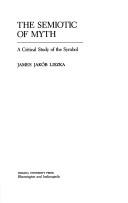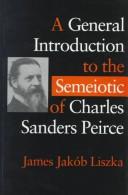| Listing 1 - 10 of 11 | << page >> |
Sort by
|

ISBN: 0585000972 9780585000978 0253335132 9780253335135 Year: 1989 Publisher: Bloomington : Indiana University Press,
Abstract | Keywords | Export | Availability | Bookmark
 Loading...
Loading...Choose an application
- Reference Manager
- EndNote
- RefWorks (Direct export to RefWorks)
Myth. --- Symbolism. --- Myth --- Symbolism --- Religion --- Philosophy & Religion --- Mythology, Comparative --- Representation, Symbolic --- Symbolic representation --- Mythology --- Emblems --- Signs and symbols --- Demythologization --- God --- Gods

ISBN: 0253330475 Year: 1996 Publisher: Bloomington Indiana University Press
Abstract | Keywords | Export | Availability | Bookmark
 Loading...
Loading...Choose an application
- Reference Manager
- EndNote
- RefWorks (Direct export to RefWorks)
The nineteenth-century American philosopher and scientist Charles Sanders Peirce is considered to be one of the founders of semiotic, or the theory of signs. Although Peirce was a prolific writer, he never published his work on signs in an organized fashion, and as a result the scope of his thought is difficult to grasp. In this book, James Jakob Liszka presents a systematic and comprehensive account of Peirce's theory. Although there are excellent critical and expository studies of Peirce's semiotic, this book is the first to integrate all the various branches of semiotic into a coherent picture of what Peirce meant by the discipline. A general introduction for those unfamiliar with Peirce's theory, it is also an attempt to resolve some of the scholarly issues that surround the great American philosopher, and to help achieve some consensus on the more controversial matters of interpretation. Liszka begins with a general overview of the discipline of semeiotic (which is Peirce's preferred spelling). Semeiotic plays a critical role in the system of sciences as Peirce understood it. Since all investigation involves signs, semeiotic is pivotal since it not only provides a general understanding of signs, but also investigates their proper use in the process of inquiry, for both the natural sciences and cultural studies. The character of semeiotic in this regard turns out to be different from the semiology of Saussure, which was meant simply to be a branch of social psychology. Moreover, as a formal discipline, Peirce's semeiotic is broader than the contemporary sense of logic but incorporates most of its traditional concerns. Next, in a chapter on grammar, Liszka explores Peirce's notions of the essential characteristics of signs, their principal components, sign typology, and classification. This is followed by a discussion of critical logic, the proper use of signs in the investigation of the nature of things. Finally, Liszka explains universal rhetoric - the use of signs within discourse communities, the nature of communication, and the character of communities best suited to promote fruitful inquiry.
Semiotics --- Peirce, Charles Sanders --- Semiotics. --- Semeiotics --- Semiology (Linguistics) --- Semiotiek --- Sémiologie --- Sémiotique --- Séméiologie --- Séméiotique --- 82:003 --- 82:003 Semiotiek in de literatuur --- Semiotiek in de literatuur --- Semantics --- Signs and symbols --- Structuralism (Literary analysis) --- Peirce, Charles S. --- Peirce, Charles Sanders, --- Peirce, C. S. --- Pirs, Charlz S., --- Peirce, Charles Santiago Sanders, --- Pʻo-erh-ssu, --- Pʻo-erh-ssu, Chʻa-li-ssu, --- Purs, Charls, --- Пърс, Чарлс, --- Contributions in semiotics --- Congresses --- Peirce, Charles S. - (Charles Sanders), - 1839-1914 - Contributions in semiotics. --- Chaersi Sangdesi Piersi, --- 查尔斯·桑德斯·皮尔斯,

ISBN: 0253335132 Year: 1989 Publisher: Bloomington, Ind. Indiana University Press
Abstract | Keywords | Export | Availability | Bookmark
 Loading...
Loading...Choose an application
- Reference Manager
- EndNote
- RefWorks (Direct export to RefWorks)
Comparative religion --- Ethnology. Cultural anthropology --- Semiotics --- Myth. --- Symbolism.

ISBN: 0585001197 9780585001197 0253330475 9780253330475 Year: 1996 Publisher: Bloomington Indiana University Press
Abstract | Keywords | Export | Availability | Bookmark
 Loading...
Loading...Choose an application
- Reference Manager
- EndNote
- RefWorks (Direct export to RefWorks)
The nineteenth-century American philosopher and scientist Charles Sanders Peirce is considered to be one of the founders of semiotic, or the theory of signs. Although Peirce was a prolific writer, he never published his work on signs in an organized fashion, and as a result the scope of his thought is difficult to grasp. In this book, James Jakob Liszka presents a systematic and comprehensive account of Peirce's theory. Although there are excellent critical and expository studies of Peirce's semiotic, this book is the first to integrate all the various branches of semiotic into a coherent picture of what Peirce meant by the discipline. A general introduction for those unfamiliar with Peirce's theory, it is also an attempt to resolve some of the scholarly issues that surround the great American philosopher, and to help achieve some consensus on the more controversial matters of interpretation. Liszka begins with a general overview of the discipline of semeiotic (which is Peirce's preferred spelling). Semeiotic plays a critical role in the system of sciences as Peirce understood it. Since all investigation involves signs, semeiotic is pivotal since it not only provides a general understanding of signs, but also investigates their proper use in the process of inquiry, for both the natural sciences and cultural studies. The character of semeiotic in this regard turns out to be different from the semiology of Saussure, which was meant simply to be a branch of social psychology. Moreover, as a formal discipline, Peirce's semeiotic is broader than the contemporary sense of logic but incorporates most of its traditional concerns. Next, in a chapter on grammar, Liszka explores Peirce's notions of the essential characteristics of signs, their principal components, sign typology, and classification. This is followed by a discussion of critical logic, the proper use of signs in the investigation of the nature of things. Finally, Liszka explains universal rhetoric - the use of signs within discourse communities, the nature of communication, and the character of communities best suited to promote fruitful inquiry.
Semiotics. --- Semiotics --- Languages & Literatures --- Philology & Linguistics --- Semeiotics --- Semiology (Linguistics) --- Semantics --- Signs and symbols --- Structuralism (Literary analysis) --- Peirce, Charles S. --- Peirce, Charles Sanders, --- Peirce, C. S. --- Pirs, Charlz S., --- Peirce, Charles Santiago Sanders, --- Pʻo-erh-ssu, --- Pʻo-erh-ssu, Chʻa-li-ssu, --- Purs, Charls, --- Пърс, Чарлс, --- Chaersi Sangdesi Piersi, --- 查尔斯·桑德斯·皮尔斯, --- Contributions in semiotics.
Book
ISBN: 9780367746001 9780367750862 9781003160892 Year: 2021 Publisher: New York, N.Y. Routledge, Taylor & Francis Group
Abstract | Keywords | Export | Availability | Bookmark
 Loading...
Loading...Choose an application
- Reference Manager
- EndNote
- RefWorks (Direct export to RefWorks)
This book presents a comprehensive and systematic picture of Charles Peirce’s ethics and aesthetics, arguing that Peirce established a normative framework for the study of right conduct and good ends. It also connects Peirce’s normative thought to contemporary debates in ethical theory.Peirce sought to articulate the relation among logic as right thinking, ethics as good conduct and, in an unorthodox sense of aesthetics, the pursuit of ends that are fine and worthy. Each plays an important role in ethical life. Once aesthetics has determined what makes an end worthy and admirable, and ethics determines which are good and right to pursue, logical and scientific reasoning is employed to figure the most likely means to attain those ends. Ethics does the additional duty of ensuring that the means conform to ideals of conduct. In the process, Peirce develops an interesting theory of moral motivation, an account of moral reasoning, moral truth, and a picture of what constitutes a moral community.
Peirce, Charles Sanders, --- Critique et interprétation. --- General ethics --- Aesthetics --- Peirce, Charles Sanders
Book
ISBN: 9781438485874 9781438485898 Year: 2021 Publisher: Albany, N.Y. SUNY Press
Abstract | Keywords | Export | Availability | Bookmark
 Loading...
Loading...Choose an application
- Reference Manager
- EndNote
- RefWorks (Direct export to RefWorks)
Book
ISBN: 1003160891 1000415597 1003160891 1000415600 Year: 2021 Publisher: New York, NY : Routledge,
Abstract | Keywords | Export | Availability | Bookmark
 Loading...
Loading...Choose an application
- Reference Manager
- EndNote
- RefWorks (Direct export to RefWorks)
"This book presents a comprehensive and systematic picture of Charles Peirce's ethics and aesthetics, arguing that Peirce established a normative framework for the study of right conduct and good ends. It also connects Peirce's normative thought to contemporary debates in ethical theory. Peirce sought to articulate the relation among logic as right thinking, ethics as good conduct and, in an unorthodox sense of aesthetics, the pursuit of ends that are fine and worthy. Each plays an important role in ethical life. Once aesthetics has determined what makes an end worthy and admirable, and ethics determines which are good and right to pursue, logical and scientific reasoning is employed to figure the most likely means to attain those ends. Ethics does the additional duty of ensuring that the means conform to ideals of conduct. In the process, Peirce develops an interesting theory of moral motivation, an account of moral reasoning, moral truth, and a picture of what constitutes a moral community. Charles Peirce on Ethics, Aesthetics and the Normative Sciences will be of interest to scholars and students working on Peirce, American philosophy, and metaethics"--
Ethics. --- Aesthetics. --- Normativity (Ethics) --- Peirce, Charles S.
Dissertation
Year: 1979 Publisher: Ann Arbor University microfilms international
Abstract | Keywords | Export | Availability | Bookmark
 Loading...
Loading...Choose an application
- Reference Manager
- EndNote
- RefWorks (Direct export to RefWorks)
Book

ISBN: 9780823293070 Year: 2022 Publisher: New York, NY
Abstract | Keywords | Export | Availability | Bookmark
 Loading...
Loading...Choose an application
- Reference Manager
- EndNote
- RefWorks (Direct export to RefWorks)
Book

ISBN: 9783110854572 Year: 2019 Publisher: Berlin Boston
Abstract | Keywords | Export | Availability | Bookmark
 Loading...
Loading...Choose an application
- Reference Manager
- EndNote
- RefWorks (Direct export to RefWorks)
| Listing 1 - 10 of 11 | << page >> |
Sort by
|

 Search
Search Feedback
Feedback About UniCat
About UniCat  Help
Help News
News